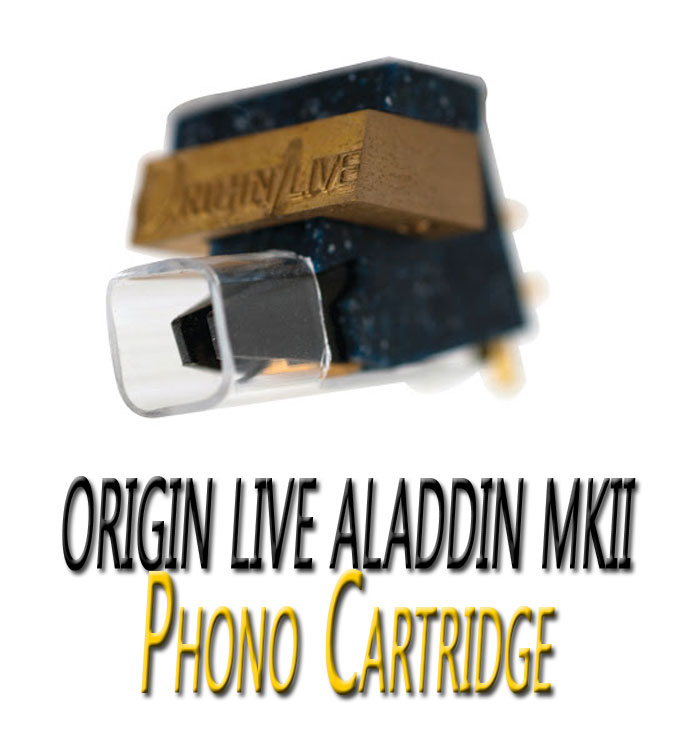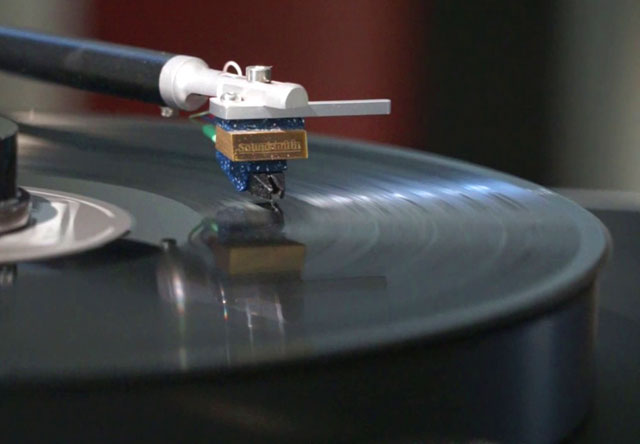ORIGIN LIVE ALADDIN MKII Phono Cartridge by Paul Szabady

A recent News Flash reveals that new LP sales have now surpassed those of new CDs. For one who remains decidedly un-enamored of digital playback and the abstract aesthetic perception it enforces, there is a kind of poetic justice in this development. The Orwellian “1984” – like mass propaganda campaign that surrounded the early days of CD’s launch (1984, very suspiciously) attempted to paint the Analogue LP as a Luddite, anachronistic, obsolete media format that was probably also contaminated with The Black Death. It is somehow very satisfying to see History repeating itself with the roles reversed.
Similarly, there are now more new turntables available than CD players. It’s clear the Vinyl Renaissance is now firmly established as a fait accompli and that LP playback is widely understood as another viable (superior, I would say) approach to listen to music. Development of turntables, tonearms, phono preamplifiers, and phono cartridges have also definitively blossomed during this Renaissance.
The Origin Live Aladdin 2 phono cartridge is a fixed-coil/moving iron-type incorporating a low-mass line-contact stylus and a new special aluminum-alloy based cantilever. It generates a 2.4 mV output and works into a conventional moving-magnet phono stage (38 to 42 dB of gain.) Being a moving-iron design, it is unaffected by capacitance loading. It is austerely packaged in a handsome wooden box with basic instructions incised on the box’s bottom. Origin Live will include a more detailed set-up and instruction manual to be included with the Aladdin. The Allen-head bolts that hold the cartridge into the box also serve as head-shell mounting bolts for the Aladdin’s threaded attachment holes. A removable stylus guard is included. The Aladdin is sourced from US manufacturer Soundsmith and is essentially a Zephyr MK III. The Aladdin costs 1139 UK Pounds, or US$ 1182 (based on no VAT and the exchange rate on 10/15/2020.)
Reviewing tonearms and phono cartridges are the two most harrowing audio tasks, especially if one leans towards the thick-thumbed and impatient. One tends to be highly biased for items that work superbly on first attempts at installation and set-up, though this is too often merely a matter of dumb luck and personal bio-rhythms. I think I am one of the few American males who read (and follow) product instructions. I used a combination of instructions and recommendations from both Soundsmith’s website and that of Origin Live to set-up and correctly adjust the Aladdin 2 and auditioned the cartridge in three different tonearms – the Origin Live Onyx, Silver MKII, and Enterprise MK3C – in three different systems.
Most of my auditioning were with the Aladdin MKII mounted on an Origin Live Enterprise 3C arm on an OL Resolution MK4 turntable. I used OL’s Discovery 2, the Graham Slee Accession MM, EAR 834P, and Pure Sound P10 phono stages into the PrimaLuna Dialogue Premium tube line-stage preamp. The power amp was an EICO HF89 tube amp driving my long-time reference Sound Lab Dynastat loudspeakers.
The Aladdin didn’t prove to be fussy about tracking force, and I set it at 2 grams, right in the middle of its recommended range. Azimuth and general alignment were also easy, aided by Soundsmith’s quality-control in cantilever/stylus assembly orientation and their easily visible exposure.
Although Soundsmith mentions that the Aladdin/Zephyr allows some latitude in getting VTA/SRA just right, I was astounded by how much the Aladdin’s performance deteriorated by too much negative tonearm-height settings (tonearm tilted towards the arm pivot.) This is a phenomenon inherent in all line-contact styli, and Origin Live’s tonearms are ruthless in revealing when it is set-up wrong, but also sledge-hammer-to-the-head obvious when you’ve got it nailed. Both Origin Live and Soundsmith recommended setting the tonearm parallel to the record as a starting point, and I followed OL’s recommendation to tune VTA/SRA by ear, as outlined on their website.
Sometimes one nails this setting in the first few tries; other times, one can fool around for hours before getting it Goldilocks just right. Getting it right is quintessential for all line-contact styli. I also set anti-skate according to Soundsmith’s novel recommendations. Since neither SRA nor anti-skate can ever be 100% perfect and accurate, as both vary according to changes in modulation and depth of the record grooves, one has to optimize.
Origin Live recommends a loading impedance equal to or greater than 47 Ohms; Soundsmith states a 47K Ohm load. Not finding any difference in alternative loadings, I used the conventional MM load of 47K Ohms.
I’m no stranger to fixed-coil/moving-iron/variable-reluctance cartridges, having used the type (Grado) since the mid-1970s in my attempt to get Classical Music (especially the violin) to sound natural. My favorite phono cartridge of all time is The Cartridge Man MusicMaster, which also uses the same generating principle. (Rest in peace, the late and great, and sorely missed, Leonard Gregory.)
 The Aladdin is my first deep exposure to a Soundsmith cartridge. Soundsmith has been very successful in their advocacy of the fixed-coil design, and founder Peter Ledermann has become something of a Guru, especially among the US reviewer/audiophile community. The old Manichean split-world of moving magnet vs. moving-coil has now become a Trinity, with fixed-coil cartridges equal contenders.
The Aladdin is my first deep exposure to a Soundsmith cartridge. Soundsmith has been very successful in their advocacy of the fixed-coil design, and founder Peter Ledermann has become something of a Guru, especially among the US reviewer/audiophile community. The old Manichean split-world of moving magnet vs. moving-coil has now become a Trinity, with fixed-coil cartridges equal contenders.
A signature aspect of moving-iron cartridges has been midrange naturalness and beauty. The Aladdin 2 certainly follows that tradition, offering a rich, harmonically-full depiction of midrange instruments. Since at least 80% of all music occurs in the midrange, including the human voice, getting it Really Right allows everything else to fall readily into place. It is part of the reason why tube electronics are still held as optimum by so many serious listeners and why so many UK speakers sound so natural and non-fatiguing (think original QUAD ESL, Harbeth, Spendor, et al.)
In step with the Aladdin’s very natural sounding midrange is an exceptionally vivid and ultra-dynamic bass register. Double basses, drums, and other bass/mid-bass instruments sound terrifically large and weighty without sounding over-blown or exaggerated. The timing and rhythmic aspects of this full and almost life-like bass performance is coherent and driving. Far too often, this kind of full bass response is compromised by poor timing and rhythmic blurring. Not so with the Aladdin II. Boogie Fools and Polyrhythmicists, please take note.
The organic weight and dynamics of the Aladdin’s bass and midrange performance are reflected in its terrifically large and spacious sound-stage production. My Sound Lab Dynastats is a line-source, 6-foot tall electrostatic panel crossing over to a dynamic woofer at 250 Hz, which extends bass flat to 22 Hz in my reference listening room. The Aladdin can produce sonic images that extended far beyond the loudspeakers and the boundaries of the room. Image size was also enormous and approached full-sized, especially when compared to the more compromised-in-placement speakers in my two other listening rooms, which struggled to let the Aladdin’s imaging and sound-staging abilities to emerge fully.
The Aladdin’s frequency-response sounded continuously equal from top to bottom, its line-contact stylus smoothly integrating treble information harmonically to the lower-pitched instruments that produced the fundamental note. The Aladdin was notably free of grain and false brightness in the upper midrange and treble, allowing complete enjoyment of bright recordings that could sound piercing with other cartridges. This characteristic helped eliminate listening fatigue and allowed emergence of the sheer beauty of instrument sonority.
I’m sure Soundsmith would link this freedom from hash and harshness to their newly developed aluminum-based alloy cantilever:
– “It features a newly developed aluminum alloy – the same one we are now using in the Paua MKII, just released. This new metal alloy has unique dualistic properties, providing stiffness in the ranges required as well as damping exactly where it’s needed – and by the proper amount – in the most critical parts of the sonic spectrum. The result is a cartridge that will slam your Rock and Roll while providing a new level of linearity and clarity for the most complex classical and jazz passages.”-
I’ve grown accustomed to the performance of line-contact styli attached to boron, diamond, beryllium, sapphire, and ruby cantilevers. They simply sound faster than the average aluminum cantilever. They can provide a step up in transient response and inter-transient silence that results in a highly detailed and extended high-frequency response that more obviously reproduces the natural overtones of notes lower down the frequency range.
The Aladdin’s new aluminum-alloy cantilever is definitely not the average aluminum type: it is entirely free from iciness, brittleness, and hard edge, and sounds more organic than “Hi-Fi”, dulcet, if you will. It may not quite match the transient speed of the best of these other cantilever materials, lacking that last bit of ultimate air, high-frequency sparkle, and focus on some speakers. That is to say, it doesn’t provide “Hi-Fi” Cheap Thrills unless of course, one finds the natural and organic a thrilling experience. The Aladdin’s ability to extract beautiful tones from acoustic instruments and to communicate the drive and full-bodied-ness of Rock and other heavily rhythm-driven music should compensate for most listeners. The Aladdin’s way of rendering bright-ish recordings listenable and enjoyable will likely prove endearing and welcome to listeners of all musical genres.
As the cartridge world expands and gets more populated, the number of cartridge choices also expands and gets more complicated. LP listeners have never had it so good. Those looking for an organic and non-artificial-sounding phono cartridge that can play all genres of music while re-creating timbral beauty and full-bodied rhythmic thrust could find the Aladdin 2 exactly what they are looking for.

![]()
paul szabady
Specifications:
Price: US$ 1,118
£1,139.00
Address: Origin Live
Unit 5 362B Spring Road
Southampton
Hampshire
SO19 2PB
UK
Phone: +44 (2380) 578 877
Email: originlive@originlive.com
Website: https://www.originlive.com/
Stereo Times Masthead
Publisher/Founder
Clement Perry
Editor
Dave Thomas
Senior Editors
Frank Alles, Mike Girardi, Russell Lichter, Terry London, Moreno Mitchell, Paul Szabady, Bill Wells, Mike Wright, and Stephen Yan,
Current Contributors
David Abramson, Tim Barrall, Dave Allison, Ron Cook, Lewis Dardick, John Hoffman, Dan Secula, Don Shaulis, Greg Simmons, Eric Teh, Greg Voth, Richard Willie, Ed Van Winkle, Rob Dockery, Richard Doron, and Daveed Turek
Site Management Clement Perry
Ad Designer: Martin Perry










Be the first to comment on: ORIGIN LIVE ALADDIN MKII Phono Cartridge by Paul Szabady